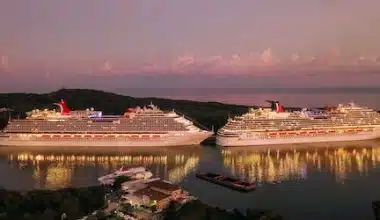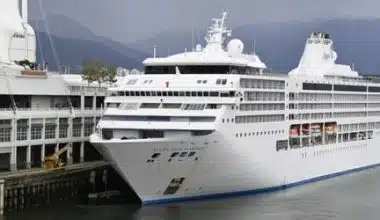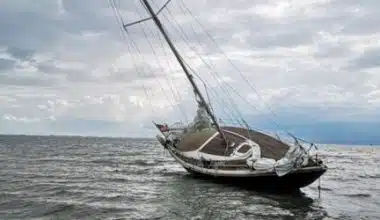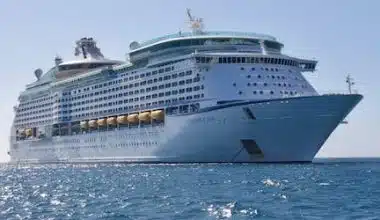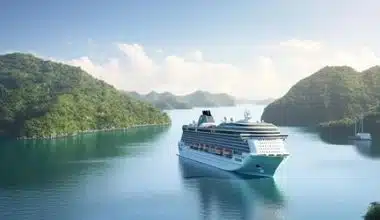How fast can cruise ships truly travel given their size and the number of activities they offer on board? Here are all the answers to your questions concerning how fast cruise ships go at night and in MPH.
The Oasis Class of cruise ships from Royal Caribbean needs to be moved with a combination of power generation and efficiency. In the end, the less energy is needed overall, the easier something is to start. Modern cruise ships can go from port to port and even continent to continent. They are fairly enormous and can be viewed up close.
Cruise ships cruise at an average speed of 20 knots at night, allowing guests to enjoy daytime sightseeing. They provide daily nighttime entertainment in addition to late-night eating, quiet spaces, nocturnal pools, nightclubs, bars, and casinos. Additionally, passengers can enjoy a variety of cuisines and a comfortable resting environment on board these ships. To maximize overall operations, cruise lines take operational efficiencies into account, such as crew shift patterns and maintenance needs.
How Fast Do Cruise Ships Go?
Cruise ships can accelerate to a reasonable speed when necessary, depending on the specific vessel. One knot is equal to 1.15078 miles per hour on land, and cruise ship speeds are expressed in terms of knots.
According to Royal Caribbean, the speed of its cruise ships can range from 18 to 20 knots, depending on the particular ship and the route taken. On land, this translates to a speed of 20 to 23 miles per hour.
But how quickly can they rise if necessary? With a top speed of more than 25 knots during her sea testing in 2016, Harmony of the Seas was at the time the fastest cruise ship in Royal Caribbean’s fleet.
In actuality, ships never travel close to their top speed since doing so would be bad for fuel efficiency. They compute an average that accounts for both traveling with and against ocean waves to determine a ship’s top speed. Similar to how the strength of a tailwind or headwind can affect an airplane’s top speed, the weather has a significant impact on how quickly a ship might sail.
Similarly to this, a ship’s displacement, hull, propeller condition, or draft can all affect its top speed.
Factors that Determine Cruise Ship Speed
The speed of cruise ships can vary depending on several factors. They comprise
#1. Ship size and design
A cruise ship’s design and size might affect its speed. Larger ships may go faster and typically have more powerful engines. Additionally, streamlined hull designs that lower drag and increase efficiency can enable faster-moving ships.
#2. Engine Power
The power of a cruise ship’s engines has a significant impact on its speed. Ships can go quicker and with more propulsion thanks to higher-powered engines. The type of fuel used, such as diesel or a gas turbine, can also affect a ship’s speed.
#3. Distance and Itinerary
The distance a cruise ship must travel and the places it stops along its route can affect its speed. To arrive at ports on time, ships may need to adhere to a strict schedule, which can affect their cruising speed. Higher speeds may be necessary to maintain the itinerary across longer distances.
#4. Environmental Factors
Weather elements, including wind, waves, and currents, can affect a cruise ship’s speed. A ship can speed up in favorable tailwinds even though strong headwinds slow it down. When encountering choppy waves, ships may need to slow down for the comfort and safety of the passengers.
#5. Fuel Cost and Efficiency
To cut costs and their negative environmental impact, cruise companies strive to maximize fuel efficiency. Some ships may decide to cruise at a slower speed to save fuel because operating at lower speeds can increase fuel efficiency.
#6. Considerations Regarding Safety
Cruise ships place a high focus on safety. Ships may slow down in bad weather or when passing through crowded places to maintain stability, maneuverability, and passenger safety.
#7. Comfort of the Traveler
The goal of cruise ships is to make their guests as comfortable as possible. Increased movement and vibration brought on by faster speeds could make passengers less comfortable. Ships may decide to travel more slowly to lessen these effects and guarantee a comfortable trip.
#8. Environmental laws are item
Cruise ships are subject to several environmental rules and regulations, including those that control emissions and stop the disturbance of marine life. Many areas have speed limitations to protect marine habitats or reduce pollution. To abide by these regulations, ships may alter their speed.
Along with cargo ships, ferries, and recreational boats, cruise ships use the same waterways as other boats. Cruise ships may need to change their speed to maintain safe distances and prevent collisions due to navigational considerations and traffic management.
#10. Operational Efficiency
Cruise lines determine the speed of their ships by taking operational efficiency into account. To increase the overall effectiveness of the ship’s operations, factors including crew shift schedules, maintenance needs, and turnaround times at ports can all have an impact on the cruising speed.
How Fast Do Cruise Ships Go at Night?
Cruise ships move just as quickly at night as they do during the day. The typical speed of a modern cruise ship is 20 knots or 23 miles per hour. They might alter their speed based on the timetable and the need to be at the next port on time. Cruise ships usually travel at a speed that enables them to arrive at the next port around sunrise, allowing passengers to enjoy sightseeing during the day. The noise levels aboard cruise ships are kept to a minimum so that guests can sleep soundly at night.
Cruise ships offer a variety of daily entertainment options to keep guests entertained, such as:
#1. Shows for entertainment
Nighttime entertainment on cruise ships frequently includes a wide range of acts, including Broadway-style plays, live music performances, comedy shows, and themed parties. Passengers have access to these shows for nighttime entertainment.
#2. Nightclubs and bars
On board nightclubs and bars, travelers can dance, listen to live music and mingle. These places are frequently open late into the night, giving travelers a fun atmosphere.
#3. Casinos
Onboard casinos on many cruise ships are open at night. Players can try their luck at a variety of games, including roulette, blackjack, poker, and slot machines.
#4. Nighttime Dining
Onboard restaurants on cruise ships frequently stay open late or offer 24-hour room service as late-night options. Even at night, passengers can choose from a range of cuisines and dining settings.
#5. Quiet Places
Cruise ships may feature dedicated quiet rooms or lounges where guests can unwind, read a book, or have a quiet discussion if they’re looking for a more laid-back and tranquil setting.
#6. Nighttime Jacuzzi and Pool
Some cruise ships allow guests to unwind and swim under the stars by keeping their pools and jacuzzis open late into the evening. To provide a relaxing ambiance, these places could also feature ambient lighting and music.
#7. Snacks and Buffets Available Late
On cruise ships, late-night buffets and other snack options are typically available for travelers who grow peckish after hours. These offers could include a variety of dishes, desserts, sandwiches, and other small nibbles.
#8. Videogame arcades
A variety of video games and interactive activities are available at gaming arcades on cruise ships that are open late at night for both adults and children to enjoy.
#9. Evening exercise sessions
On cruise ships, nocturnal exercise courses like yoga, Pilates, or Zumba are frequently available for fitness aficionados. Even after the sun sets, you may stay active and motivated by taking these classes.
How Fast Do Cruise Ships Go In Mph?
The speed of cruise ships is measured in knots, where 1 knot is equivalent to about 1.15 miles per hour. They move at rates between 20 and 24 knots, or around 23 and 28 miles per hour (MPH). The precise speed can change based on the size, shape, and circumstances of the ship, including the weather and the route. Ships may change their pace to improve the safety and comfort of their passengers or to get to their destinations faster.
Cruise Ship Types and Their Different Speeds in MPH
Different types of cruise ships are available to accommodate diverse travel needs and experiences. Size, propulsion system, and route all affect speed. Typical types and speeds include
#1. River cruise vessels
River cruise ships are built to travel across inland waterways and rivers. Compared to ocean-going cruise ships, they are smaller and provide a more personal experience. Depending on the weather and rules of the river, river cruise ships travel at speeds of between 4–20 knots (5–23 mph).
#2. Yachts and little expedition ships
Yachts and small expedition ships offer a more intimate and personalized cruising experience. These vessels are designed for exploration and can go great distances. Depending on the size and purpose of the ship, their highest speeds can range from 10 to 18 knots (12 to 21 mph).
#3. Tall Ships
Tall ships compete in races and regattas frequently and run on wind power. Tall ships may travel at rates of 8–17 knots (9–20 mph) when under sail, though this can vary widely depending on factors like the wind.
#4. Oceanliners
Ocean liners are large, opulent ships designed for extended trips across open oceans. Ocean liners were once known for their rapid speeds and capacity to cross the Atlantic Ocean in a short amount of time. The Queen Mary 2, one of the most recent ocean liners, cruises at a speed of roughly 22–24 knots (25–28 mph), prioritizing luxury and elegance over speed.
#5. Catamarans
Multiple-hulled catamarans provide stability and roominess. They are well-liked for cruising in tidal areas and can go faster because of their construction. Depending on the size and intended use of the boat, catamaran cruising speeds can range from 15 to 25 knots (17 to 29 mph).
#6. Mega Ships
Mega-ships, the biggest cruise ships in the business, can carry thousands of guests. The onboard facilities and entertainment opportunities are prioritized on these ships. Mega ships typically travel at a speed of 20 to 24 knots (23 to 28 mph), though this might vary.
#7. Ferries and fast boats
For shorter distances, vehicles and people can be transported via ferries and high-speed vessels. These boats emphasize efficiency and speed, and they can travel at speeds of up to 50 knots (or 29–58 mph).
#8. Mid-sized Ships
Mid-sized ships provide a good mix of onboard comforts and a more personal cruise experience. They are often bigger than boutique or expedition ships but smaller than mega-ships. Mid-sized ships go between 18 and 22 knots (21 and 25 mph).
#9. Boutique Ships
Smaller ships, known as “boutique ships,” provide a more individualized and intimate sailing experience. Compared to larger vessels, these can navigate through narrower rivers and smaller ports. For boutique ships, 15–18 knots (17–21 mph) is the cruising speed.
#10. Expedition Ships
Expedition ships are made for daring tourists looking for distinctive and immersive experiences in far-off places like the polar regions or the Amazon rainforest. These vessels cruise at 12 to 16 knots (14 to 18 mph) and are designed to resist adverse conditions.
How Fast Does the Average Cruise Ship Go?
A modern cruise ship travels at a maximum speed of about 30 knots (34.5 miles per hour), with an average speed of about 20 knots (23 miles per hour). The strength of a cruise ship’s engines, the weather, and the sea conditions can all have an impact on the actual speed at which it travels. To avoid storms or choppy waves, ships may need to sail faster, but if they encounter choppy swells, they may need to sail more slowly. Additionally, as they get closer to the shore, cruise ships usually slow down.
How Fast Does a Royal Caribbean Cruise Ship Go?
The normal cruising speed of Royal Caribbean cruise ships is between 18 and 20 knots or 20 and 23 miles per hour. The precise speed can change based on the ship and the route.
What Is the Fastest Ship in the World?
The fastest ship in the world is the high-speed catamaran HSC Francisco, built in Hobart, Tasmania. With a top speed of 58 knots (67 mph; 107 km/h), it is currently the fastest passenger ship in operation. The vessel’s owner and operator is the Argentine-Uruguayan ferry company Buquebus, which uses LNG to propel it. The HSC Francisco travels the 146 nautical miles (270 km; 168 mi) maritime route between Montevideo, Uruguay, and Buenos Aires, Argentina. It can transport more than 120 cars and more than 950 passengers.
Is a Cruise Ship Faster Than a Car?
In general, cruise ships’ top speeds are lower than those of automobiles. Cruise ships typically cruise at speeds of about 18 to 22 knots, which is equivalent to 20 to 25 miles per hour, while cars may reach speeds of over 100 mph. However, a cruise ship’s primary function is to provide leisurely and delightful travel experiences rather than quick conveyance. Speed is not given priority on cruise ships; instead, comfort, safety, and fuel efficiency are.
How Much Does a Cruise Ship Cost?
Cruise ship construction costs can range from hundreds of millions to billions of dollars. In the 2000s, the average cost of building a cruise ship exceeded $500 million, while the most recent ships can cost more than $1 billion. The Regent Seven Seas Explorer, the most opulent cruise ship, cost $450 million to construct. The price of a ship varies amongst cruise lines, with Royal Caribbean paying $669 million on average. A cruise ship’s upkeep and operation can also run into millions of dollars annually.
Summary
When asking how fast a cruise ship can go, you’re asking about theoretical because ships will only travel as fast as they need to, which for true cruise ships is more like 25 knots.
Cruise ships travel relatively slowly, with an average speed of 18 to 22 knots (20 to 25 miles per hour). Ocean liners like the Queen Mary 2 can reach top speeds of 30 knots.
- BEST TIME TO CRUISE THE CARIBBEAN
- HOW TO CALCULATE GAS FOR A TRIP: Detailed Guide
- MOST LUXURIOUS CRUISE LINES in 2023-2024
- BEST CARIBBEAN CRUISE DEALS IN 2023-2024
- BEST SMALL SHIP CRUISES TO ALASKA

